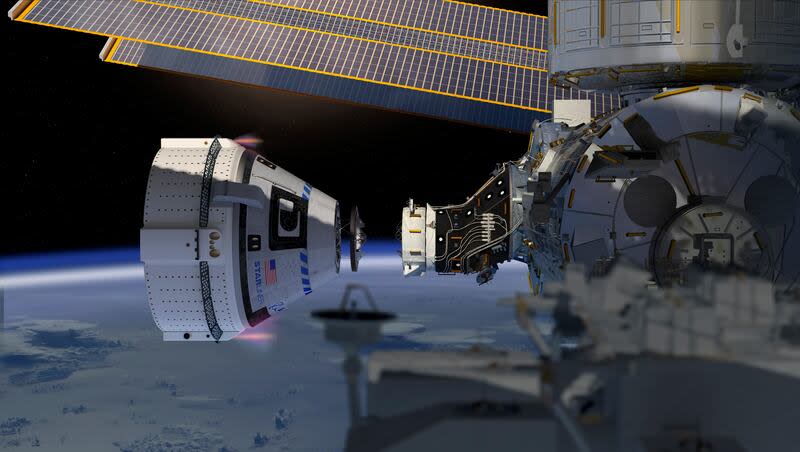Historic Boeing Starliner space flight could land in Utah

Boeing is finally ready to carry astronauts into space.
Back in 2014, NASA announced a pair of “groundbreaking” contracts, granted to Boeing and SpaceX, aiming to bring the job of ferrying astronauts to and from the orbiting International Space Station, a task that was assumed by Russia’s Roscosmos following the retirement of the Space Shuttle program in 2011, back to the U.S.
Boeing’s decades-long partnership with NASA and jumbo $4.2 billion contract, compared to SpaceX’s $2.6 billion, led many to believe early on that the legacy aircraft and aerospace company would outpace Elon Musk’s scrappy space startup and be first to the finish line in NASA’s new Commercial Crew Transportation Capability effort.
But a series of delays allowed SpaceX to leapfrog Boeing in the work to develop a new crew transport vehicle and in 2020, SpaceX’s Dragon 2 Crew Capsule became the first U.S.-launched spaceflight to carry astronauts to the ISS since the final, 13-day shuttle mission performed by Atlantis.
Now, Boeing is set to join the Uber-esque astronaut transport service realm with the debut crewed flight of its Starliner capsule, set to launch from the Kennedy Space Center in Cape Canaveral, Florida, early next month.
On Thursday, NASA astronauts Butch Wilmore and Suni Williams arrived in Florida to begin final preparations for a flight that is currently scheduled to launch May 6, at the earliest. The two NASA veterans will be aboard Boeing’s Starliner capsule and powered into space by a Universal Launch Alliance Atlas V rocket.
In case you missed it, the first @NASA_Astronauts to fly @BoeingSpace's #Starliner arrived at @NASAKennedy today. Hear from Suni Williams and Butch Wilmore as they prepare for the Crew Flight Test launch on May 6: https://t.co/0kscfxtM6U pic.twitter.com/J0gy9tmM5f
— NASA (@NASA) April 25, 2024
Starliner is expected to dock with the ISS about 24 hours after launch and Wilmore and Williams will spend about a week aboard the station before returning on a mission focused on testing and confirming Starliner’s capabilities.
“Do we expect it to go perfectly? This is the first human flight (with) the spacecraft,” Williams said during a Thursday press conference. “I’m sure we’ll find things out.
“That’s why we do this. This is a test flight. So when you do test, you expect to find things. We expect to find things.”
Utah could play a role in Starliner’s debut crew flight as the U.S. Army’s Dugway Proving Ground in the state’s west desert is among a short list of possible landing sites, which also includes two targets in the vast White Sands Missile Range, New Mexico, and Willcox, Arizona, according to NASA. Edwards Air Force Base in California is available as a contingency landing site.
While a parachute-assisted ground landing is expected, the Starliner capsule is also capable of a water landing.
Boeing’s bumpy road to space
Boeing has had to overcome issues both within and without its Starliner program on the path to next month’s expected launch, while SpaceX has now completed 13 crewed missions aboard its Dragon capsule.
An uncrewed Starliner test flight in 2019 exposed software and communications issues that combined to derail an attempt to dock with the ISS and almost led to the crew ship’s destruction, per CBS News.
A hoped-for second test flight in 2021 was scrubbed after engineers discovered corroded valves in the spacecraft’s propulsion system, pushing the next attempt to 2022. And while that flight was a success, potential problems with Starliner’s parachute lines were revealed as well as the need to replace about a mile of electrical tape that was found to be flammable.
Along the way, Boeing has had to navigate major issues in its commercial airliner division, including the tragic 737 Max plane crashes and, more recently, production and quality control issues that were highlighted when a Boeing plane flown by Alaska Airlines lost a door plug component in the passenger cabin during a flight.
Wilmore and Williams will be evaluating Starliner’s systems throughout all phases of the mission, including testing out manual override capabilities, abort systems and the spacecraft’s ability to function as an emergency shelter while docked with the ISS. NASA says visiting spacecraft can be used as safe havens in the event of a contingency aboard the ISS, such as depressurization, fire or risk of collision with orbital debris.
If the Starliner mission is a success, NASA reports it will complete work to certify the spacecraft as an operational crew system for long-duration rotation missions to the space station, beginning with NASA’s Boeing Starliner-1 expected to launch in 2025.

